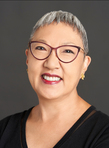Eugenia Kim's Blog, page 2
February 22, 2017
Without You, There Is No Us: My Time with the Sons of North Korea's Elite, by Suki Kim
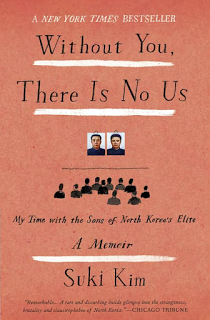
Suki Kim went undercover as a Christian missionary among Christian missionaries who went undercover to North Korea under the guise of educators to young men of that nation's privileged elite. Admittedly an atheist, her double subterfuge is compounded by the oppressive regime under which she became a professor of ESL. I devoured this book in one morning both for its stellar writing and for a story that grips from the get-go and doesn't let go. The rarity of her experience, and the slow burn of its impact on her character and her life are intimately portrayed, and her love for the youth she instructed shines through with to augment the conviction of her purpose in going there. It is a book of rare courage, in which betrayal is necessarily a part of its existence, but one that feels justified by the exposure of the complexity of what it must be like for even the cream of the crop to live in this cloistered land.
Published on February 22, 2017 09:03
June 3, 2014
Here I Am, by Patti Kim, illustrated by Sonia Sánchez

Vivid illustrations enhance this wordless book, showing a touching story of surprising depth. A recently arrived immigrant boy in an American city feels alienated by the language and all that is new to him. His longing for his homeland is embodied in a seed he carries in his pocket. But he loses the seed, and his search to recover it leads him to adventures that open his eyes to wonderful discoveries and friendship. The universal story of the irony of loss that leads to acceptance and growth is portrayed with a rich, yet simple, sequence of lively drawings that express his shift in understanding the language and culture.
Published on June 03, 2014 14:37
May 29, 2014
The Fruit 'n Food, by Leonard Chang
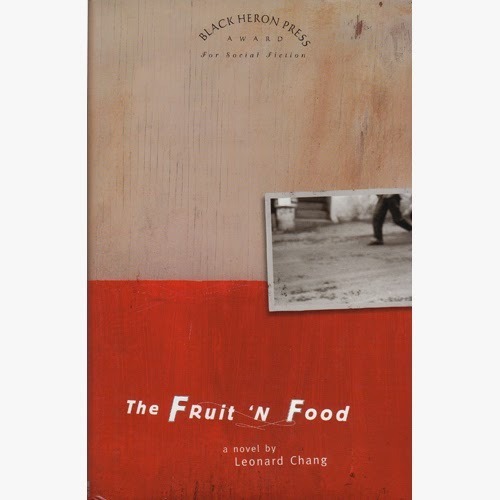 This early KA novel (first published 1996), centered around the Fruit ’n Food grocery, focuses on a somewhat aimless young man who gets involved with the grocer's daughter. The compelling story shows a Korean perspective of the race riots of the 1990s.
This early KA novel (first published 1996), centered around the Fruit ’n Food grocery, focuses on a somewhat aimless young man who gets involved with the grocer's daughter. The compelling story shows a Korean perspective of the race riots of the 1990s.
Published on May 29, 2014 16:33
April 21, 2014
Racial Asymmetries: Asian American Fictional Worlds, by Stephen Sohn
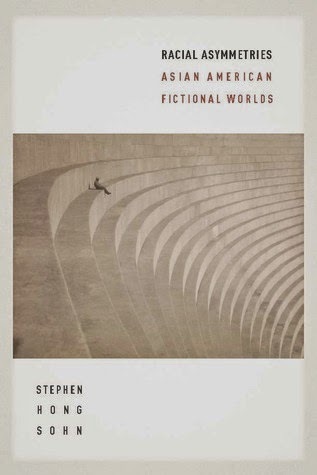 Literature Review from ENTROPY, by Peter Tieryas Liu. Stephen Hong Sohn has written one of the smartest, analytical books on literature in the past year with Racial Asymmetries: Asian American Fictional Worlds. Sohn isn’t just a scholar, but an excavator, an archaeologist, an explorer, and a poet, traversing racial narratives to challenge “the tidy links between authorial ancestry and fictional content, and between identity and form, to expand what is typically thought of as Asian American culture and criticism.”
Literature Review from ENTROPY, by Peter Tieryas Liu. Stephen Hong Sohn has written one of the smartest, analytical books on literature in the past year with Racial Asymmetries: Asian American Fictional Worlds. Sohn isn’t just a scholar, but an excavator, an archaeologist, an explorer, and a poet, traversing racial narratives to challenge “the tidy links between authorial ancestry and fictional content, and between identity and form, to expand what is typically thought of as Asian American culture and criticism.”
Published on April 21, 2014 21:19
April 11, 2014
Modern Korean Literature, Peter H. Lee
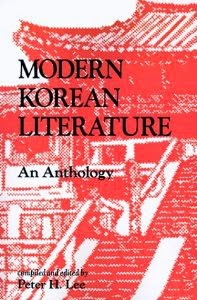 Translations of contemporary (up to 1990) Korean writings include poetry, fiction, essays, and drama, predominantly focus on the difficult, tragic and resilient history of Korea during the twentieth-century.
Translations of contemporary (up to 1990) Korean writings include poetry, fiction, essays, and drama, predominantly focus on the difficult, tragic and resilient history of Korea during the twentieth-century.
Published on April 11, 2014 22:31
A Gesture Life by Chang-rae Lee
Rich language describes a Korean-Japanese-American former WWII medic living quietly in Connecticut in a small provincial town. Because of his past in the Pacific War post of Burma in 1945, and the Korean comfort women there, he lives a gesture life, one where all is sacrified in order to fit in and have surface equanimity. His adopted Japanese daughter hates him; guesses that she serves some
Published on April 11, 2014 22:07
Native Speaker by Chang-rae Lee
With this 1996 debut novel, Chang-rae Lee entered the pantheon of literary best-sellers. Part mystery, part spy story, part immigrant experience, the story examines the character and identity of Henry Park. With this character, Lee begins his theme of studying the externally remote, yet internally tortured man—one who is haunted by trauma or tragedy in the past, most often relating to events in
Published on April 11, 2014 21:52
October 24, 2013
Turn to the East, by Caroline Singer and C. Le Roy Baldridge
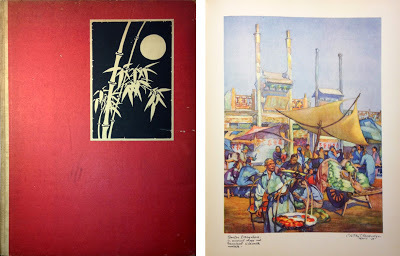
As a piece of "living history," this fascinating large-format volume brings together the narrative of Caroline Singer and artwork of her husband, Roy Baldridge, of their year (likely 1924-25) in the Far East, including Japan, Korea and China. What makes this work fascinating is the sensitivity of these Westerners about what they experience and how it compares to other Western and political prejudices. From the Foreword: "So here…rendered in two different media, brought together because they are complementary, the imprint of the East on two different personalities.
"It is no easy task, this rendering. Only the dull rush heedlessly into print with 'impressions of the Orient." To those with more sensitive perceptions, the East is too overwhelming for easy articulateness. It intimidates. The first few hours in Peking not only confuse, they frighten. Color is too vivid, motion in too unfamiliar a rhythm, mass too imposing, the content of the life about one too alien for translation into term intelligible to the Western mind. Another barrier also intervenes: the prejudices of foreign residents. To escape the influence of either their over-enthusiasm or maladjustment is difficult for one thrown suddenly into an alien culture."
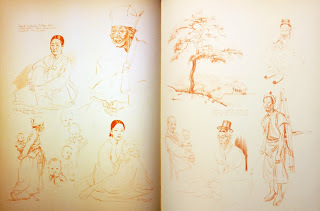
But the two manage, despite all that. She overcomes her culture to strip and change in front of a crowd of welcoming swimmers (men and women) to Japanese men's underwear (the only garments that would fit her), enjoying the swim, only to realize the white garments are transparent in the water. But by then, she recognizes that no one cares, and so she lets it go and enjoys the company and the swim, to the horror of her husband. His illustrations are without prejudice, sensitive to the reality he portrays and skilled in his artistry to show it as real.
For Korea, they take note of the modernization that Japan brought with colonization, but also note that it was unwelcome, and she tells one particular story that exemplifies the effect of such change—hard white highways built by the Japanese, excellent railways, and in particular one steel bridge:
"Last night from the steel bridge a Korean girl threw herself into the river. Her body was found by fishermen at dawn.
"Not much over sixteen, she had been wed to a youth of her own age, wed in the traditional manner by arrangement between families. Such a marriage being almost inviolable, a divorce would be the affair not of individuals, but of clans. From the first, the girl was gentle, knowing a wife's duty. But the young man was of a newer mold, a rebel against tradition, against old-fashioned authority. He wished to choose a wife for himself. [He went] to the local authorities, the new rulers whose power is naturally greater than that of a subject's father…[and appealed] in the name of the law as new as the bridge, and as alien. What he demanded was granted—a modern divorce.
"She who had been a bride was now neither a wife nor yet a maid free to reenter her father's house, eligible again for marriage. No respected Korean family would accept her as daughter-in-law. Scorned publicly by her husband, she was disgraced, and her shame became the shame of her bewildered relatives. In her father's house she was, as in her husband's, unwelcome.
"Wearing fresh white linens from her bridal chest, she ran, last night, to meet death. Through stinking streets, past barred gates of unfriendly houses, past barred gates of the mission's gardens, she ran, a whimpering thing in white, while we lay between decent sheets, dreaming. This is the story I got this morning from the missionary's wife, whose cook had it from the gatekeeper, he having listened to the group of peddlers.
"Today I will not go down to the river."
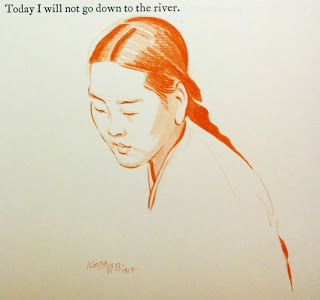
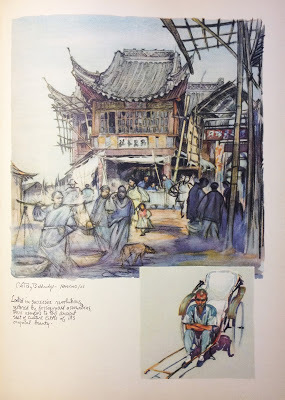
Published on October 24, 2013 09:45
September 18, 2013
The Korean Americans, by Brian Lehrer (The Immigrant Experience series)
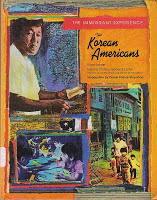 A middle-grade book that appears to be part of a series on the immigrant experience. What strikes me foremost is that it was published in 1988, four years before Sa-i-gu, the Los Angeles race riots, which was a benchmark for change in Korean American and American relations. And so, in that light, it's interesting to see how this book both attempts to delineate the particularities of the Korean American experience while simultaneously reinforcing burgeoning stereotypes of the KA culture. The photographs and brief modern Korean history up until the repeal of the Oriental Exclusion Act are interesting. A good “history in it’s time” brief reading.
A middle-grade book that appears to be part of a series on the immigrant experience. What strikes me foremost is that it was published in 1988, four years before Sa-i-gu, the Los Angeles race riots, which was a benchmark for change in Korean American and American relations. And so, in that light, it's interesting to see how this book both attempts to delineate the particularities of the Korean American experience while simultaneously reinforcing burgeoning stereotypes of the KA culture. The photographs and brief modern Korean history up until the repeal of the Oriental Exclusion Act are interesting. A good “history in it’s time” brief reading.
Published on September 18, 2013 19:49
I Married a Korean by Agnes Davis Kim
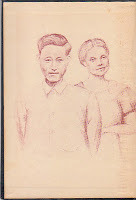 My family knew Agnes Davis Kim as "Auntie Agnes," though she wasn't a blood relative. My Korean parents knew her, perhaps from Korea, perhaps afterwards as immigrants in America, but her book was always on our shelves, and we would visit Auntie Agnes and Uncle David on their farm in the Catskills every summer when I was young. I saw a calf being birthed on their farm, circled cow pies, drove in the herd, woke early to watch the milking machines, had my first (awful) taste of raw milk straight from the cow (blue strings in it), and smelled chitterlings cooking for the first time ever when I sneaked into the worker's quarters. I slept on a cot in the living room with my 5 other siblings, and roamed the fields and woods during unforgettable farm summers. I finally read her book, and though I remember seeing her lovely and informative illustrations, it is only now that I can appreciate what she went through to have accomplished an interracial marriage in that time. The American community in Korea was against it, aghast, really, and she faced them all and insisted on the choice of love. She adapted her life with pioneer-woman strength to the more close-to-the-earth kind of life of Korean women of the day, and created many modern conveniences within her own home (especially the kitchen) in order to run a smooth household. Among them: a method of creating hot running water, learning how to perserve and keep food through the winter the Korea way, learning how to be subservient in appearances for her husband's sake, and creating and running a successful women's clinic in the midst of Japanese colonial oppression. I had never known she was medically trained, nor had I known the kind of racism she had experienced for her choice to marry. It is an informative and interesting book that portrays these kinds of personal struggles, as well as the inventive solutions she applied to overcome them. Her love of both her husband, his family, and the Korean people is palpable, and honorable, and her illustrations bring to life in detail the challenges of her life in Korea. The image isn't the book cover (a navy blue cloth binding) but is the frontispiece, one of Mrs. Kim’s illustrations presented throughout the book.
My family knew Agnes Davis Kim as "Auntie Agnes," though she wasn't a blood relative. My Korean parents knew her, perhaps from Korea, perhaps afterwards as immigrants in America, but her book was always on our shelves, and we would visit Auntie Agnes and Uncle David on their farm in the Catskills every summer when I was young. I saw a calf being birthed on their farm, circled cow pies, drove in the herd, woke early to watch the milking machines, had my first (awful) taste of raw milk straight from the cow (blue strings in it), and smelled chitterlings cooking for the first time ever when I sneaked into the worker's quarters. I slept on a cot in the living room with my 5 other siblings, and roamed the fields and woods during unforgettable farm summers. I finally read her book, and though I remember seeing her lovely and informative illustrations, it is only now that I can appreciate what she went through to have accomplished an interracial marriage in that time. The American community in Korea was against it, aghast, really, and she faced them all and insisted on the choice of love. She adapted her life with pioneer-woman strength to the more close-to-the-earth kind of life of Korean women of the day, and created many modern conveniences within her own home (especially the kitchen) in order to run a smooth household. Among them: a method of creating hot running water, learning how to perserve and keep food through the winter the Korea way, learning how to be subservient in appearances for her husband's sake, and creating and running a successful women's clinic in the midst of Japanese colonial oppression. I had never known she was medically trained, nor had I known the kind of racism she had experienced for her choice to marry. It is an informative and interesting book that portrays these kinds of personal struggles, as well as the inventive solutions she applied to overcome them. Her love of both her husband, his family, and the Korean people is palpable, and honorable, and her illustrations bring to life in detail the challenges of her life in Korea. The image isn't the book cover (a navy blue cloth binding) but is the frontispiece, one of Mrs. Kim’s illustrations presented throughout the book.
Published on September 18, 2013 19:43

